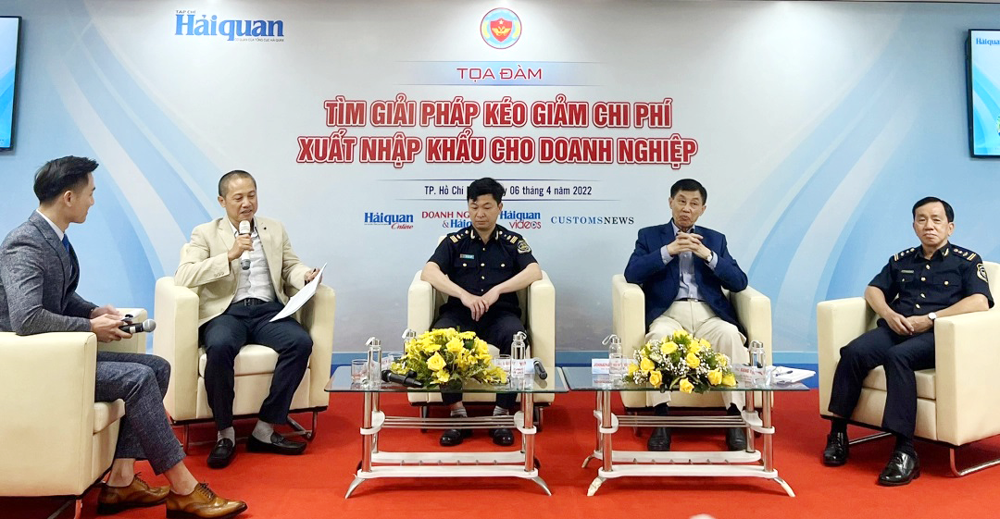Vietnam Seafood
What solutions to reduce import and export costs for businesses?
Many businesses have to accept to break even and even losses to keep customers when production costs are continuously pushed up, which reduces their competitiveness.
On April 6 in HCM City, a seminar “Finding solutions to reduce import-export costs for businesses” was held by the Customs Newspaper, with the participation of the Customs Supervision and Administration Department under the General Department of Customs,
customs departments in the southern provinces and cities, business associations and about 100 import-export enterprises.
Vu Thi Anh Hong, Editor-in-Chief of Customs Newspaper said that Vietnam is currently a trading partner of more than 200 countries and territories. It is also one of the few Southeast Asian countries with high economic openness. With 17 Free Trade Agreements (FTAs) signed, negotiated and implemented, including new generation FTAs such as CPTPP and EVFTA, it is an opportunity for import and export activities in Vietnam to these markets.
However, the outbreak of the COVID-19 pandemic has greatly affected the economic development of the country. Particularly the import-export activities of enterprises have been significantly affected.
Moreover, the Russian-Ukrainian military conflict and the world oil price increase caused higher transportation and logistics costs, pushing up import and export costs.

According to businesses, as costs have been pushed up, the competitiveness of Vietnamese goods has decreased, and many exporters accept break-even or even suffer losses to export goods to maintain business relationships with customers.
Meanwhile, recently, the container shipping fee continues to be announced by many shipping lines to increase up to 20 per cent although the price is already quite high – several times higher than before the pandemic.
The high import-export costs make many enterprises fail to compete.
Dao Duy Tam, vice head of the Customs Supervision and Administration Department said that to make a significant contribution to reducing the time for customs clearance of goods across borders, saving a lot of costs for businesses, and helping businesses improve their competitiveness, many solutions on information technology applications have been implemented.
For examples, online customs procedures, electronic payment (E-Payment); automatic customs supervision management.
Tam said that in the coming period, Vietnam Customs would continue to promote administrative reform comprehensively to reduce the time for customs clearance of goods and create favorable conditions for enterprises, in particular, the overall redesign of the Customs IT system, towards Digital Customs, Smart Customs.
Jonathan Hanh Nguyen, Chairman of the Board of Directors of IPPG Group, shared about the impacts of the continuously increasing world oil prices and freight rates in recent years on import-export activities of enterprises.
Head of the Department of Customs and Trade Facilitation – Vietnam Association of Logistics Service Enterprises Tran Viet Huy said that it was necessary to apply transparent and effective customs procedures to reduce costs and increase predictability.
It was also needed to quickly build and use systems for the electronic exchange of data between enterprises, customs and related agencies based on the existing national one-stop network and progress on the Customs software platform.
Huy also suggested that the General Department of Customs should strengthen training for customs brokerage agents; strengthen propaganda to use the services of customs agents because this was a proven trend in the world.
Dang Thai Thien, Deputy Head of Management Supervision Department, HCM City Customs Department said that Cat Lai port of Saigon Newport Corporation had an exploited cargo volume accounting for 50 per cent of the country’s market share, more than 80 per cent of cargo volume at HCMC seaports. The port’s annual growth rate is 10 per cent but the traffic infrastructure cannot keep up with the increased volume of cargo
As a result, traffic jams and congestion occurred at Cat Lai port and affected traffic in surrounding areas.
To reduce 70 per cent of the time of receiving and checking customs documents as well as reducing the time of physical inspection of goods, the HCM City Customs Department issued Decision 2318, promulgating “Project Facilitation trade: Customs procedures in Logistics activities and anti-jamming of import and export goods at Cat Lai port” with three solutions. The first solution is to build a closed, centralised working model, implementing customs procedures 24/7 based on establishing a separate information exchange channel between Customs authorities, Saigon Newport Corporation and enterprises. The second solution is to arrange a separate cargo loading area with a plan for freight forwarding at the wharf and separate moving channels for container trucks of enterprises. The third solution is to apply information technology to build an online monitoring system for the process of customs clearance – import and export goods delivery and assessment of the satisfaction level of customs service users for customs officers and employees of the customs authority.
Author: Nguyen Thuy
Translated by Hien Anh
(Source: https://vietnamagriculture.nongnghiep.vn/)



 Tiếng Việt
Tiếng Việt